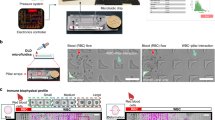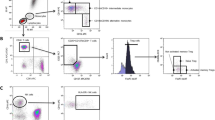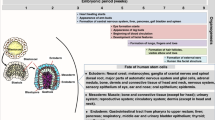Abstract
The cellular aspects of the immunologic development of the fetus during pregnancy have been studied mainly in populations living in economically well developed countries, and there is no data concerning variation of the neonatal cellular immune system in geographically distinct areas with different environments. Here, we report a comparative immunologic marker analysis of the circulating mononuclear cell subsets in unstimulated cord blood of newborns from Gabon and Austria, assessing the activation and maturation status of T and B lymphocytes as well as antigen-presenting cells. Cells and markers hypothesized to be modulated by frequent exposure to microorganisms and parasites such as regulatory T cells and the expression of toll-like receptor 2 on antigen-presenting cells were also studied. We found marked differences in terms of expression of immunologic markers between the two populations, pointing to a comparatively enhanced maturation status of the neonatal immune system in general in the African setting. The observations suggest that environmental factors, including differential exposure to pathogens as well as nutritional differences, may have substantial impact on the development of the fetal immune system.
Similar content being viewed by others
Log in or create a free account to read this content
Gain free access to this article, as well as selected content from this journal and more on nature.com
or
Abbreviations
- BDCA:
-
blood dendritic cell antibody
- CBMC:
-
cord blood mononuclear cells
- CD:
-
cluster of differentiation
- CTLA:
-
cytotoxic T lymphocyte antigen
- FACS:
-
fluorescent-activated cell sorting
- GMFI:
-
geometric mean fluorescence intensity index
- TLR:
-
toll-like receptor
References
Szepfalusi Z, Pichler J, Elsasser S, van Duren K, Ebner C, Bernaschek G, Urbanek R 2000 Transplacental priming of the human immune system with environmental allergens can occur early in gestation. J Allergy Clin Immunol 106: 530–536
Szepfalusi Z, Nentwich I, Gerstmayr M, Jost E, Todoran L, Gratzl R, Herkner K, Urbanek R 1997 Prenatal allergen contact with milk proteins. Clin Exp Allergy 27: 28–35
Prescott SL, Macaubas C, Holt BJ, Smallacombe TB, Loh R, Sly PD, Holt PG 1998 Transplacental priming of the human immune system to environmental allergens: universal skewing of initial T cell responses toward the Th2 cytokine profile. J Immunol 160: 4730–4737
Jones AC, Miles EA, Warner JO, Colwell BM, Bryant TN, Warner JA 1996 Fetal peripheral blood mononuclear cell proliferative responses to mitogenic and allergenic stimuli during gestation. Pediatr Allergy Immunol 7: 109–116
Soboslay PT, Geiger SM, Drabner B, Banla M, Batchassi E, Kowu LA, Stadler A, Schulz Key H 1999 Prenatal immune priming in onchocerciasis-onchocerca volvulus-specific cellular responsiveness and cytokine production in newborns from infected mothers. Clin Exp Immunol 117: 130–137
Pit DS, Polderman AM, Schulz-Key H, Soboslay PT 2000 Prenatal immune priming with helminth infections: parasite-specific cellular reactivity and Th1 and Th2 cytokine responses in neonates. Allergy 55: 732–739
Malhotra I, Mungai P, Muchiri E, Ouma J, Sharma S, Kazura JW, King CL 2005 Distinct Th1- and Th2-Type prenatal cytokine responses to Plasmodium falciparum erythrocyte invasion ligands. Infect Immun 73: 3462–3470
Broen K, Brustoski K, Engelmann I, Luty AJ 2007 Placental Plasmodium falciparum infection: causes and consequences of in utero sensitization to parasite antigens. Mol Biochem Parasitol 151: 1–8
Adkins B, Leclerc C, Marshall-Clarke S 2004 Neonatal adaptive immunity comes of age. Nat Rev Immunol 4: 553–564
Hintzen RQ, de Jong R, Lens SM, Brouwer M, Baars P, van Lier RA 1993 Regulation of CD27 expression on subsets of mature T-lymphocytes. J Immunol 151: 2426–2435
Prabha C, Rajashree P, Sulochana DD 2008 TLR 2 and TLR 4 expression on the immune cells of tuberculous pleural fluid. Immunol Lett 117: 26–34
Hartgers FC, Obeng BB, Kruize YC, Duijvestein M, de Breij A, Amoah A, Larbi IA, van Ree R, Wilson MD, Rodrigues LC, Boakye DA, Yazdanbakhsh M 2008 Lower expression of TLR 2 and SOCS-3 is associated with Schistosoma haematobium infection and with lower risk for allergic reactivity in children living in a rural area in Ghana. PLoS Negl Trop Dis 2: e227
Yazdanbakhsh M, Kremsner PG, van Ree R 2002 Allergy, parasites, and the hygiene hypothesis. Science 296: 490–494
Adegnika AA, Agnandji ST, Chai SK, Ramharter M, Breitling L, Kendjo E, Issifou S, Yazdanbakhsh M, Kombila M, Kremsner PG 2007 Increased prevalence of intestinal helminth infection during pregnancy in a Sub-Saharan African community. Wien Klin Wochenschr 119: 712–716
Planche T, Krishna S, Kombila M, Engel K, Faucher JF, Ngou-Milama E, Kremsner PG 2001 Comparison of methods for the rapid laboratory assessment of children with malaria. Am J Trop Med Hyg 65: 599–602
D'Arena G, Musto P, Cascavilla N, Di Giorgio G, Fusilli S, Zendoli F, Carotenuto M 1998 Flow cytometric characterization of human umbilical cord blood lymphocytes: immunophenotypic features. Haematologica 83: 197–203
Appay V, Rowland-Jones SL 2002 Premature ageing of the immune system: the cause of AIDS?. Trends Immunol 23: 580–585
Imanishi K, Kato H, Fujii H, Uchiyama T 2003 Maturation of adult peripheral blood CD38(+)CD4(+) T cells demonstrated by cytokine production in response to a superantigen, TSST-1. Cell Immunol 222: 89–96
de Vries E, de Bruin-Versteeg S, Comans-Bitter WM, de Groot R, Hop WC, Boerma GJ, Lotgering FK, van Dongen JJ 2000 Longitudinal survey of lymphocyte subpopulations in the first year of life. Pediatr Res 47: 528–537
Bogunia-Kubik K, Natarajan P, Madrigal JA, Cohen SB 2002 The effect of cord blood sera on CD69 expression. Immunol Lett 84: 77–80
López-Cabrera M, Santis AG, Fernández-Ruiz E, Blacher R, Esch F, Sánchez-Mateos P, Sánchez-Madrid F 1993 Molecular cloning, expression, and chromosomal localization of the human earliest lymphocyte activation antigen AIM/CD69, a new member of the C-type animal lectin superfamily of signal-transmitting receptors. J Exp Med 178: 537–547
Bhat NM, Kantor AB, Bieber MM, Stall AM, Herzenberg LA, Teng NN 1992 The ontogeny and functional characteristics of human B-1 (CD5+B) cells. Int Immunol 4: 243–252
Kotiranta-Ainamo A, Apajasalo M, Pohjavuori M, Rautonen N, Rautonen J 1999 Mononuclear cell subpopulations in preterm and full-term neonates: independent effects of gestational age, neonatal infection, maternal pre-eclampsia, maternal betamethason therapy, and mode of delivery. Clin Exp Immunol 115: 309–314
Sakaguchi S 2005 Naturally arising Foxp3-expressing CD25+CD4+ regulatory T cells in immunological tolerance to self and non-self. Nat Immunol 6: 345–352
Sakaguchi S, Sakaguchi N, Asano M, Itoh M, Toda M 1995 Immunologic self-tolerance maintained by activated T cells expressing IL-2 receptor alpha-chains (CD25). Breakdown of a single mechanism of self-tolerance causes various autoimmune diseases. J Immunol 155: 1151–1164
Stephens LA, Mottet C, Mason D, Powrie F 2001 Human CD4(+)CD25(+) thymocytes and peripheral T cells have immune suppressive activity in vitro. Eur J Immunol 31: 1247–1254
Levings MK, Sangregorio R, Roncarolo MG 2001 Human cd25(+)cd4(+) t regulatory cells suppress naive and memory T cell proliferation and can be expanded in vitro without loss of function. J Exp Med 193: 1295–1302
Wing K, Larsson P, Sandström K, Lundin SB, Suri-Payer E, Rudin A 2005 CD4+ CD25+ FOXP3+ regulatory T cells from human thymus and cord blood suppress antigen-specific T cell responses. Immunology 115: 516–525
Shevach EM 2001 Certified professionals: CD4(+)CD25(+) suppressor T cells. J Exp Med 193: F41–F46
Birebent B, Lorho R, Lechartier H, de Guibert S, Alizadeh M, Vu N, Beauplet A, Robillard N, Semana G 2004 Suppressive properties of human CD4+CD25+ regulatory T cells are dependent on CTLA-4 expression. Eur J Immunol 34: 3485–3496
Liu E, Tu W, Law HK, Lau YL 2001 Changes of CD14 and CD1a expression in response to IL-4 and granulocyte-macrophage colony-stimulating factor are different in cord blood and adult blood monocytes. Pediatr Res 50: 184–189
Breitling LP, Fendel R, Mordmueller B, Adegnika AA, Kremsner PG, Luty AJ 2006 Cord blood dendritic cell subsets in African newborns exposed to Plasmodium falciparum in utero. Infect Immun 74: 5725–5729
Pichyangkul S, Yongvanitchit K, Kum-arb U, Hemmi H, Akira S, Krieg AM, Heppner DG, Stewart VA, Hasegawa H, Looareesuwan S, Shanks GD, Miller RS 2004 Malaria blood stage parasites activate human plasmacytoid dendritic cells and murine dendritic cells through a Toll-like receptor 9-dependent pathway. J Immunol 172: 4926–4933
Ito T, Yang M, Wang YH, Lande R, Gregorio J, Perng OA, Qin XF, Liu YJ, Gilliet M 2007 Plasmacytoid dendritic cells prime IL-10-producing T regulatory cells by inducible costimulator ligand. J Exp Med 204: 105–115
Akira S, Uematsu S, Takeuchi O 2006 Pathogen recognition and innate immunity. Cell 124: 783–801
Iwasaki A, Medzhitov R 2004 Toll-like receptor control of the adaptive immune responses. Nat Immunol 5: 987–995
Sadeghi K, Berger A, Langgartner M, Prusa AR, Hayde M, Herkner K, Pollak A, Spittler A, Forster-Waldl E 2007 Immaturity of infection control in preterm and term newborns is associated with impaired toll-like receptor signaling. J Infect Dis 195: 296–302
Triantafilou M, Gamper FG, Haston RM, Mouratis MA, Morath S, Hartung T, Triantafilou K 2006 Membrane sorting of toll-like receptor (TLR)-2/6 and TLR 2/1 heterodimers at the cell surface determines heterotypic associations with CD36 and intracellular targeting. J Biol Chem 281: 31002–31011
Bernasconi NL, Traggiai E, Lanzavecchia A 2002 Maintenance of serological memory by polyclonal activation of human memory B cells. Science 298: 2199–2202
Bernasconi NL, Onai N, Lanzavecchia A 2003 A role for Toll-like receptors in acquired immunity: up-regulation of TLR 9 by BCR triggering in naive B cells and constitutive expression in memory B cells. Blood 101: 4500–4504
Bourke E, Bosisio D, Golay J, Polentarutti N, Mantovani A 2003 The toll-like receptor repertoire of human B lymphocytes: inducible and selective expression of TLR 9 and TLR 10 in normal and transformed cells. Blood 102: 956–963
Lanzavecchia A, Sallusto F 2007 Toll-like receptors and innate immunity in B-cell activation and antibody responses. Curr Opin Immunol 19: 268–274
Lauener RP, Birchler T, Adamski J, Braun-Fahrländer C, Bufe A, Herz U, von Mutius E, Nowak D, Riedler J, Waser M, Sennhauser FH 2002 ALEX study group expression of CD14 and toll-like receptor 2 in farmers' and non-farmers' children. Lancet 360: 465–466
Acknowledgements
The authors thank first and foremost all parents and children for their exceptional devotion to the study. They are grateful to Ms Yvonne Kruize, Ms Yvonne Fillié, and Dr. Franca Hartgers for technical assistance. The authors are indebted to the nurses and midwives in Lambaréné and at General Hospital of Vienna for their assistance in the conduct of this study.
Author information
Authors and Affiliations
Corresponding author
Additional information
Supported by Netherlands Foundation for the Advancement of Tropical Research Grant W93-385 20077; EU-Project GLOFAL “Global View of Food Allergy: opportunities to study the influence of microbial exposure” FP6–2003-Food-2B.
Rights and permissions
About this article
Cite this article
Köhler, C., Adegnika, A., Linden, R. et al. Comparison of Immunological Status of African and European Cord Blood Mononuclear Cells. Pediatr Res 64, 631–636 (2008). https://doi.org/10.1203/PDR.0b013e31818718ba
Received:
Accepted:
Issue date:
DOI: https://doi.org/10.1203/PDR.0b013e31818718ba
This article is cited by
-
Genetic variations in immunomodulatory pathways to predict survival in patients with locoregional gastric cancer
The Pharmacogenomics Journal (2017)
-
Earlier infantile immune maturation is related to higher DTP vaccine responses in children
Clinical & Translational Immunology (2016)
-
Cytokine and chemokine responses to helminth and protozoan parasites and to fungus and mite allergens in neonates, children, adults, and the elderly
Immunity & Ageing (2013)
-
T-Cell Subpopulations αβ and γδ in Cord Blood of Very Preterm Infants: the Influence of Intrauterine Infection
Archivum Immunologiae et Therapiae Experimentalis (2013)
-
Tropical Medicine at the University of Tübingen
Wiener klinische Wochenschrift (2010)



